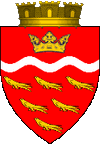mNo edit summary Tags: Visual edit apiedit |
No edit summary Tag: Visual edit |
||
| (4 intermediate revisions by the same user not shown) | |||
| Line 45: | Line 45: | ||
*[[Sevenoaks]] (Wood Town) (Torn down; citizens moved to Hastings) |
*[[Sevenoaks]] (Wood Town) (Torn down; citizens moved to Hastings) |
||
[[Category:County]] |
[[Category:County]] |
||
| − | [[Category:England]] |
||
| − | [[Category:Sussex]] |
||
Latest revision as of 13:36, 18 November 2017
| Sussex | |||
| — Duchy SussexSussex — | |||
|
|||
| Motto: WE WUN'T BE DRUV | |||
| Capital | Hastings | ||
|---|---|---|---|
| Country | Kingdom of Sussex | ||
| Duke | Allyn.brightpoint | ||
| Towns | Arundel, Lewes, Hastings, Dover | ||
| Province | Province of Southwark | ||
| Dioceses | Diocese of Southwark, Diocese of Brighton, Province of Canterbury | ||
| Discovered | 2 February 1453 | ||
| Official language | English | ||
The Duchy of Sussex is the major province in the Kingdom of Sussex. The area was formerly the oldest county in Kingdom of England, until it was liberated and formed its own independent nation. Sussex's Capital is Hastings. Sussex was discovered on February 2, 1453. Sussex has 2 Gold mines, 2 Iron mines and 1 Stone mine. The county also has 2 wood towns and 2 fish towns. Sussex has three Level Four Ports in Dover, Lewes, and Hastings. Arundel has a level three port and Canterbury has a level two port.
It is shared a border with the county of Wiltshire before mergers, now it shares a border with the county of Devon.
The Duke of Sussex also holds the office of regent for the Kingdom of Sussex. However the office of regent may be overruled by the Lord Protector or the King of Sussex.
Sussex's Separation from England[]
On 16 September 1456, Sussex Council XIX voted to Separate from the Kingdom of England, and no longer recognize King LongJohnSilver, by a vote of 8 in favour, 2 against, and 1 abstaining from voting. Those in favour of Separation from England were Shawn_math, Wench, Zerostar, Bryce, Amarilos, Zeathea, Tadulla, and Scarletscarteen. Those who voted against Separation from England were Gardexer, and Selene. Ekaterine choose to abstain on the vote, while the other remaining member of Council, Kissit had previously passed away.
In response, the then Regent of England, Chris_braveheart issued a writ of Attainder against all of the members of the Council who voted for, or abstained, from the measure to Separate from England and renounce King LongJohnSilver's authority. This meant that those councilors who had voted for, or abstained the measure to Separate, had all their titles and lands stripped from them, and they were barred from holding titles or lands in England in the future.
The House of Parliament passed a measure condemning the Separation. The official English position was that county councils lacked the authority to separate themselves from the King and England.
Sussex Council XIX's decision to Separation from England created a great deal of division and conflict within Sussex which lasted until Sussex Council XXVII's move to reunite with England on 10 January 1458. That vote followed a public vote, in which 95% of the people supported unification.
The current and past councils can be found on the Sussex Council pages.
Sussex's Liberation from England[]
In 1464, Sussex changed its status from a duchy and formed the Kingdom of Sussex. A magical sword was pulled from stone by Queen-Mother Alicia Avis O'hera, she knighted Prince Galahad Rodriguez with the sword before gifting it to her son, King Charles Rodriguez O'hera.
Prince Galahad was the first regent of Sussex, however his first act was to name himself Lord Protector of the Throne and turned regency over to the legally elected Duke of Sussex. The Duke shall rule in Sussex, however the Sussex Throne holds absolute power.

